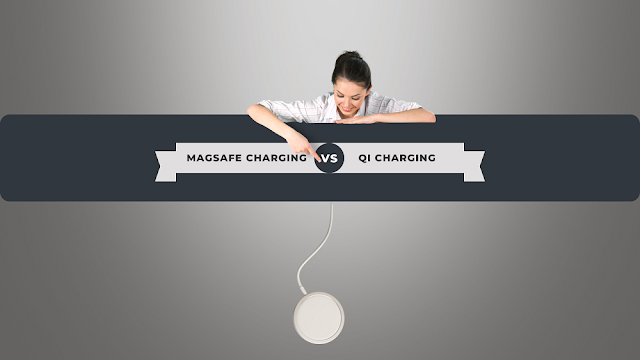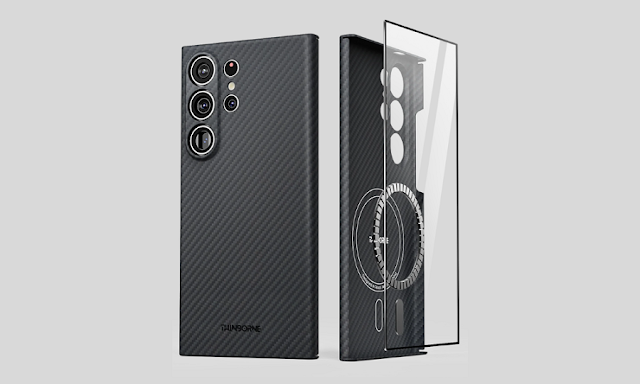The Difference Between MagSafe Charging and Qi Charging

Wireless charging has been around for some time, offering convenient and effortless ways to power up our devices. Recently, there has been much buzz about two types of wireless charging technologies, MagSafe and Qi Charging. Both are known for their fast-charging capabilities and compatibility with popular smartphones such as the iPhone 15 and Samsung Galaxy series. However, many people are left wondering if these two technologies are any different from each other or just two names used interchangeably. Today, let's talk about the differences between MagSafe and Qi Charging to help you understand which one is best suited for your needs.
What Is MagSafe Charging?
Apple recognized the need to break free from the constraints of
traditional charging methods and make charging easier and better for everyone.
So, they developed MagSafe, Apple's exclusive magnetic wireless charging
technology.
MagSafe charging works by utilizing the principle of
electromagnetic induction. The iPhone 12 and newer models connect magnetically
to accessories like the MagSafe Charger. The magnets inside both devices align
perfectly. This alignment is crucial as it ensures that the charging coils in
the charger and the device are positioned correctly to enable efficient power
transfer.
Once the devices are aligned, an electromagnetic field is created
between the coils. This field induces a current in the charged device, which
converts this energy into usable power to charge the battery.
In simpler terms, MagSafe charging eliminates the need to plug a cable in each time you want to charge your device. With its ability to deliver a speedy 15 watts of power, outpacing regular Qi charging, MagSafe emerges as a standout feature that provides users with a fast, reliable, and convenient wireless charging experience.
What is Qi Charging?
Qi charging is a method of wirelessly powering devices that
follows a universal standard set by the Wireless Power Consortium (WPC). This
standard, pronounced as "chee" and derived from the Chinese word
"vital energy," allows charging pads to deliver power to various
Qi-certified devices without needing multiple chargers.
Initially introduced in 2009, Qi charging operates on closely
coupled electromagnetic induction. This means that for charging to occur, the
device must align precisely on top of the coil on the charging pad. This
alignment ensures efficient power transfer and charging capabilities.
Over time, the Qi standard has evolved to support faster charging speeds. While the original Qi standard was limited to 5-watt charging speeds, the latest Qi2 standard enables certified phones to charge at up to 15 watts, offering users a quicker and more efficient charging experience.
MagSafe Vs Qi Charging
There are notable differences in design and functionality when
looking at MagSafe and Qi charging. Qi charging has been around for a few years
longer than MagSafe and is compatible with a wide range of devices, including
smartphones, earbuds, and smartwatches. While Qi charging eliminates the need
for cables and simplifies the charging process, one common issue is aligning
your device perfectly with the charger, sometimes requiring adjustments to find
the optimal position. Additionally, using your device while it charges on a Qi
wireless charger is not feasible as you need to place it down during charging.
On the other hand, MagSafe, a variation of Qi charging tailored
for Apple devices, utilizes magnets to ensure a secure and efficient connection
between the charging pad and the device's charging coil. MagSafe is not limited
to just Apple products. Non-Apple devices can also benefit from this technology
by using a Magnetic
phone case to enable compatibility. This means devices like the Samsung
Galaxy S24 Ultra can enjoy the convenience and speed of magnetic wireless
charging by pairing it with MagSafe-compatible accessories.
Here's a brief comparison:
Release Year: Qi Charging (2010) vs. MagSafe Charging (2020)
Charging Speed: Qi Charging (5 watts) vs. MagSafe Charging (Up to 15 watts)
Compatibility: Qi Charging (Over 9000 products) vs. MagSafe Charging (iPhone 12 and later models; adaptable to non-Apple devices with MagSafe cases)
Pros and Cons:
Qi Charging
Pros:
- Cable-free
charging
- Industry-standard
- Secure
and reliable wireless charging
Cons:
- Limited
device usability during charging
- Alignment
challenges
- Potential interruptions
MagSafe Charging
Pros:
- Faster
charging speeds
- Seamless
alignment with magnets
- Compatible with both Apple and non-Apple devices
Cons:
Designed primarily for Apple devices
In summary, while Qi charging offers broad compatibility and convenience, MagSafe stands out for its speed and efficiency, especially for Apple device users. Both methods have advantages and drawbacks, catering to different preferences and needs in wireless charging technology.
MagSafe Vs. Qi2 Charging
Understanding how these charging standards interact and the considerations for cross-compatibility is key to determining whether Qi2 chargers are compatible with MagSafe technology.
Apple's MagSafe Charging showcases the effective use of magnets in wireless charging, elevating the charging experience without causing any interference. On the other hand, the Wireless Power Consortium recent introduction of the Qi2 standard incorporates Magnetic Power Profile technology to ensure seamless alignment between devices and chargers, enhancing both charging efficiency and energy optimization.
Qi2 wireless chargers can deliver 15 watts of power to various
smartphones, including iPhones, without Apple certification. This advancement
hints at a potential future where Qi2 charging may surpass MagSafe in terms of
charging speeds. This opens up new possibilities for users looking to
wirelessly charge their devices at higher power levels beyond what
Apple-certified MagSafe chargers currently offer.
A brief comparison of MagSafe and Qi2 charging:
Release Year: MagSafe Charging (2020) vs. Qi2 Charging (2023)
Charging Speed: MagSafe Charging (Up to 15 watts) vs. Qi2 Charging (15 watts or
higher)
Compatibility: MagSafe Charging (iPhone 12 and later models) vs. Qi2 Charging
(iPhone 13 and later models; expanding compatibility with more certified
products)
Pros and Cons:
Both MagSafe and Qi2 Charging offer secure and fast wireless
charging, ensuring ease of usability.
MagSafe is primarily designed for Apple devices, while Qi2 Charging exhibits wider compatibility with an increasing range of certified products.
Final Thoughts
We have discussed the similarities and differences between MagSafe
and Qi charging technologies. While both offer convenient wireless charging
solutions for devices such as smartphones and headphones, they differ in
efficiency, compatibility, and design. However, it is worth noting that neither
technology is perfect, and both have limitations.
It is fascinating to see the rapid advancements in wireless
charging technology and how it continues to evolve over time. As we look
towards the future, it is exciting to imagine the possibilities that these
technologies could bring us from longer-range wireless charging to even more
efficient and faster charging speeds.
It's also important to consider the impact of wireless charging on
our daily lives. With fewer cords and cables cluttering our homes and
workspaces, a positive shift will be towards a more organized and efficient
lifestyle. Furthermore, as we continue to embrace a more sustainable way of
life, wireless charging technologies play a crucial role in reducing electronic
waste by eliminating the need for constant charger replacement.
Although some argue that wired charging is still superior due to
its stability and faster speeds, it is clear that wireless charging is here to
stay. Its convenience and simplicity outweigh any perceived drawbacks, making
it an increasingly popular choice among consumers.
As we move towards a more tech-reliant future, wireless charging
will continue to play a significant role in shaping our daily routines. With
constant innovation and improvements being made in both MagSafe and Qi
technologies, we can only expect bigger and better things from them in the
years to come.
